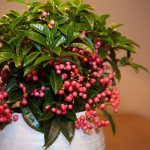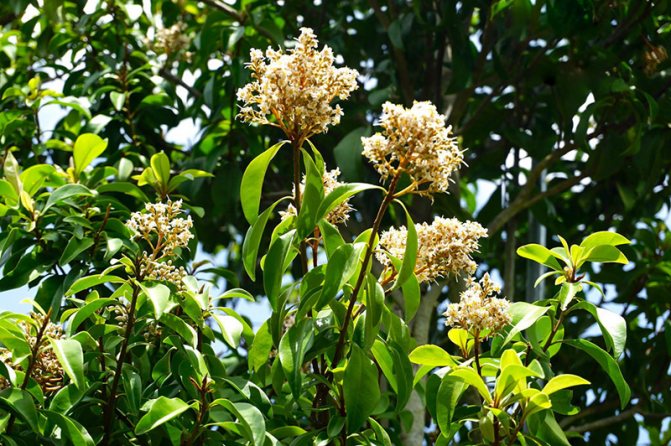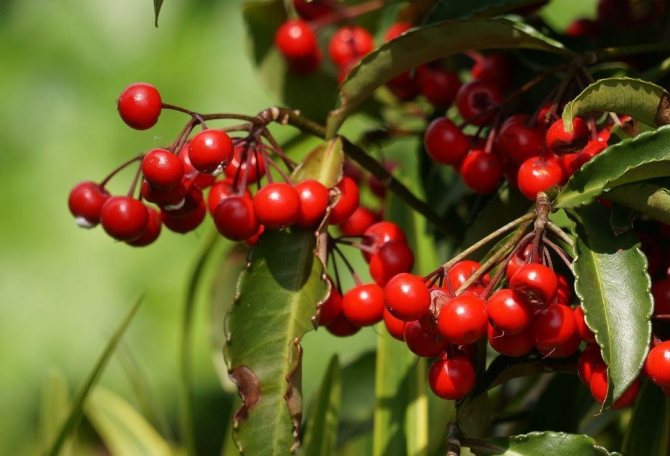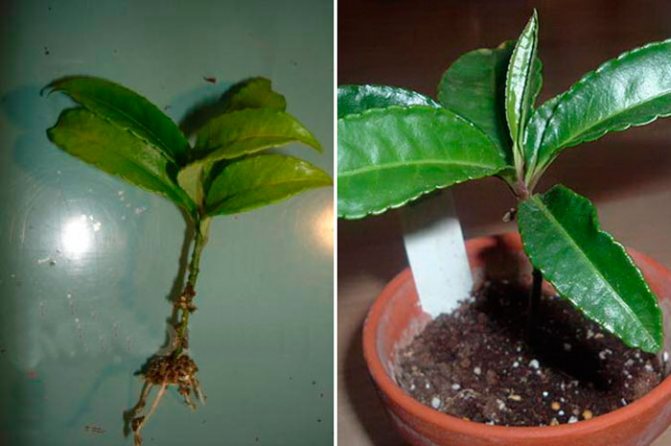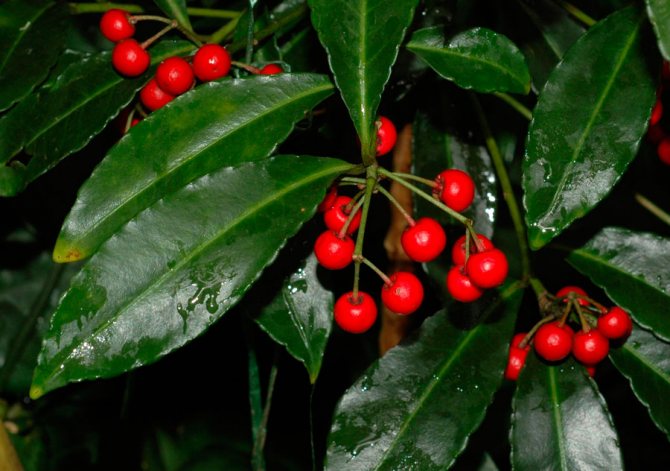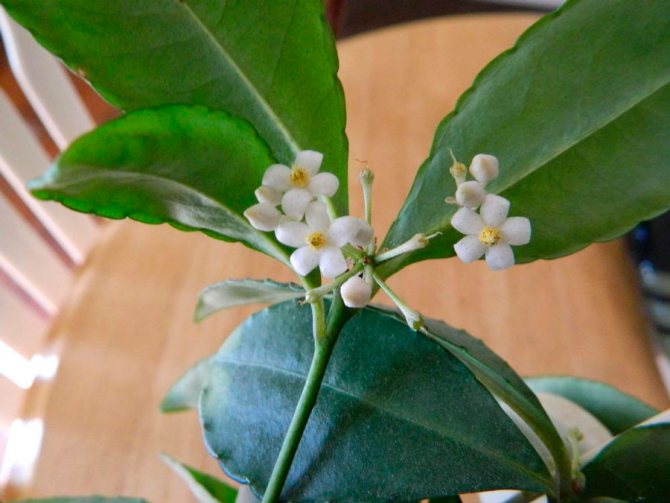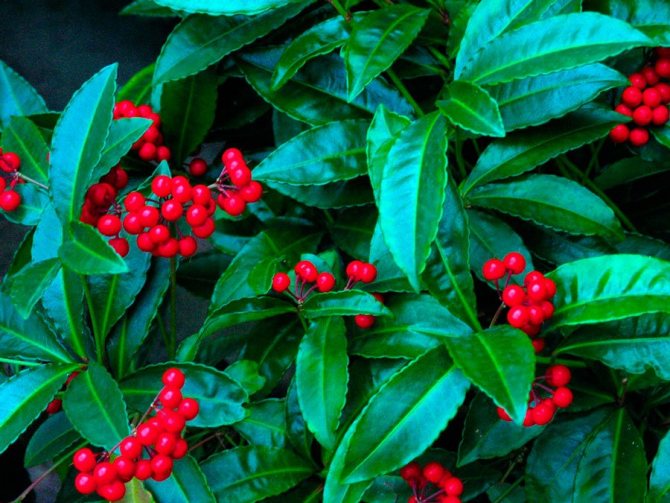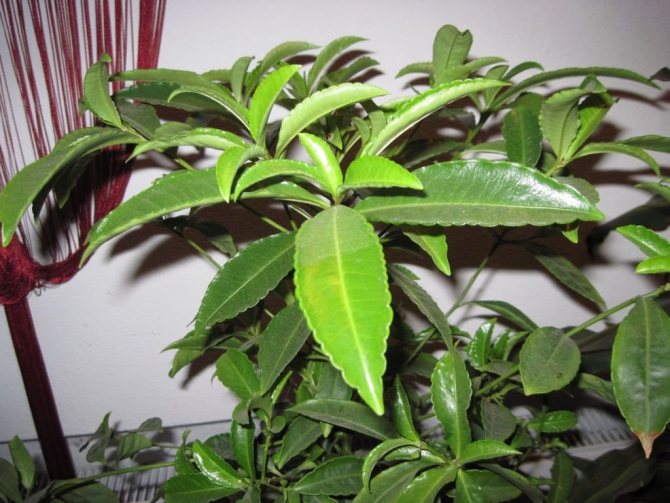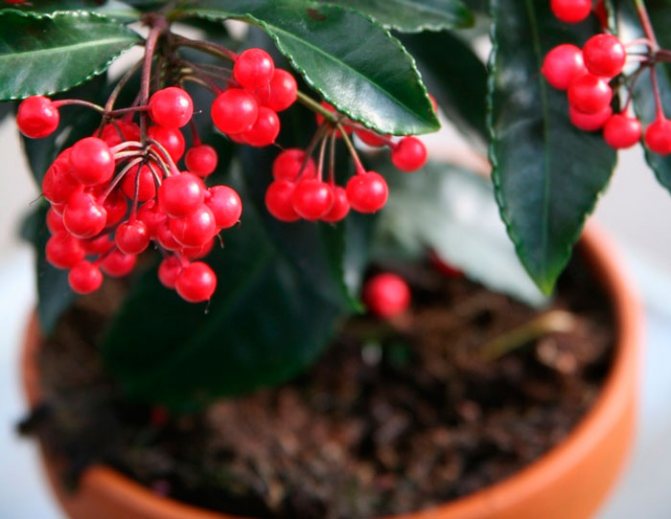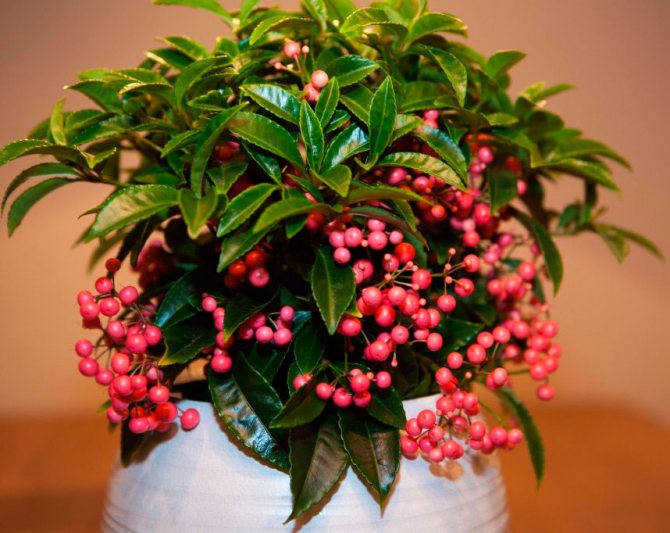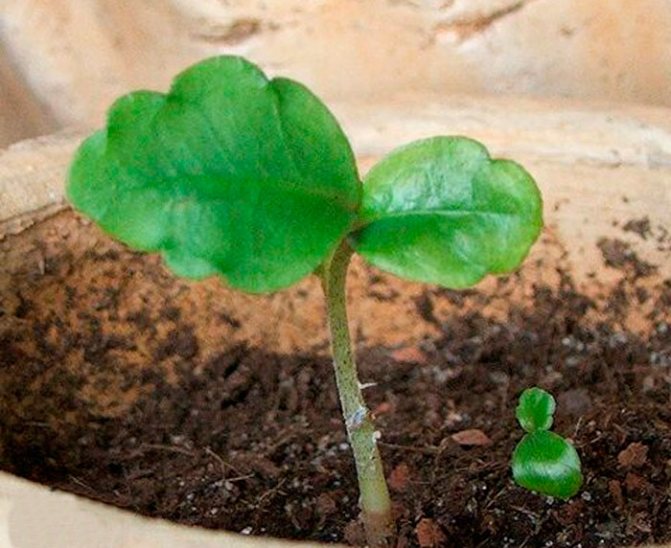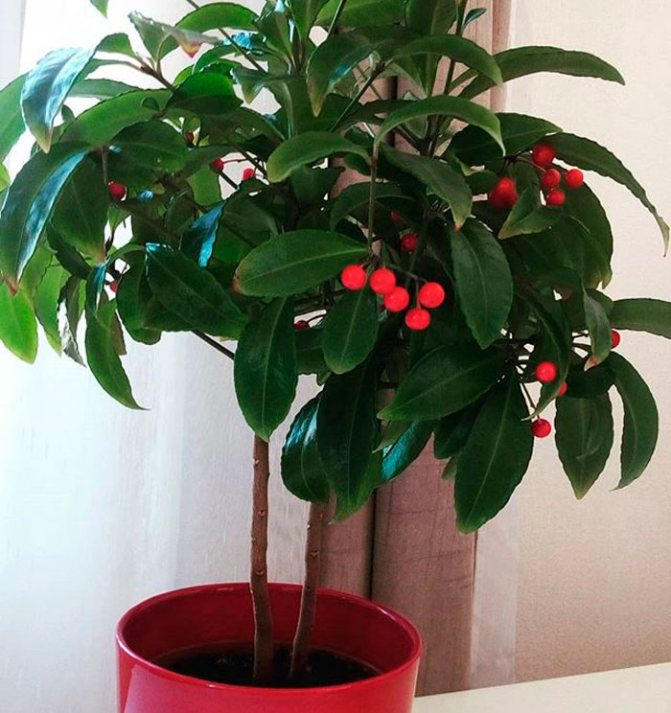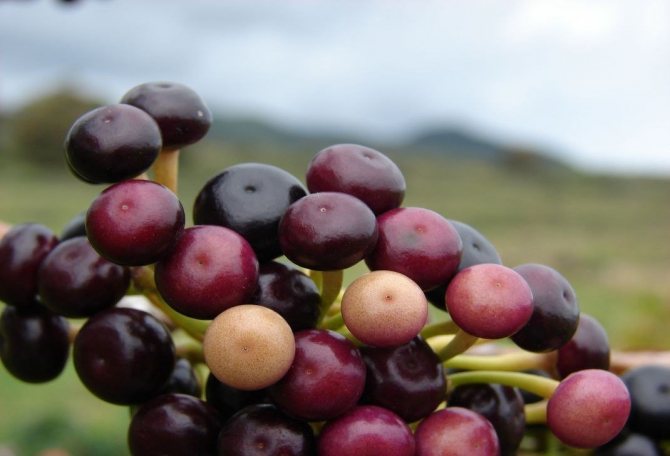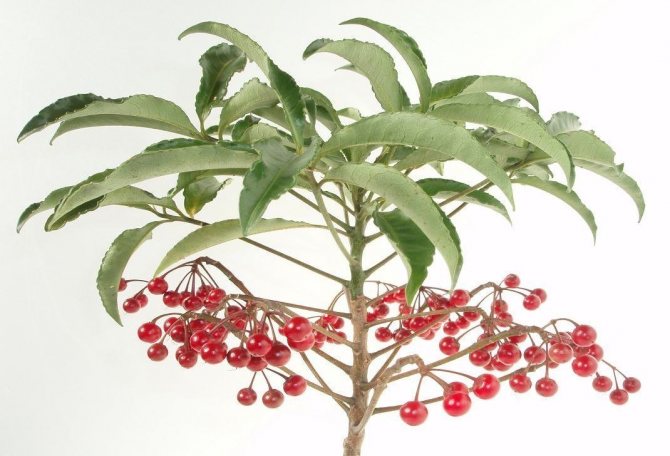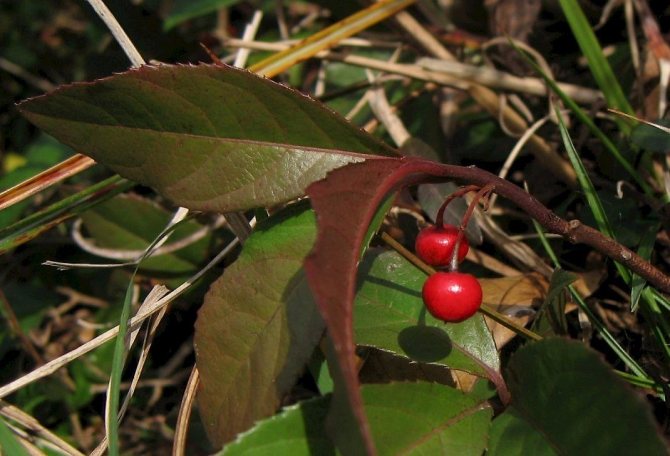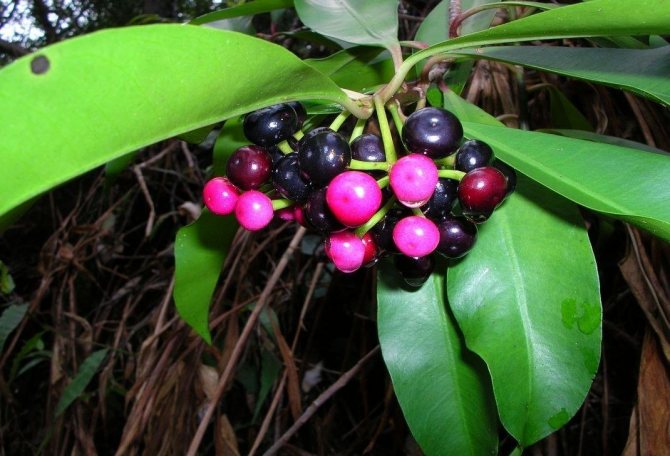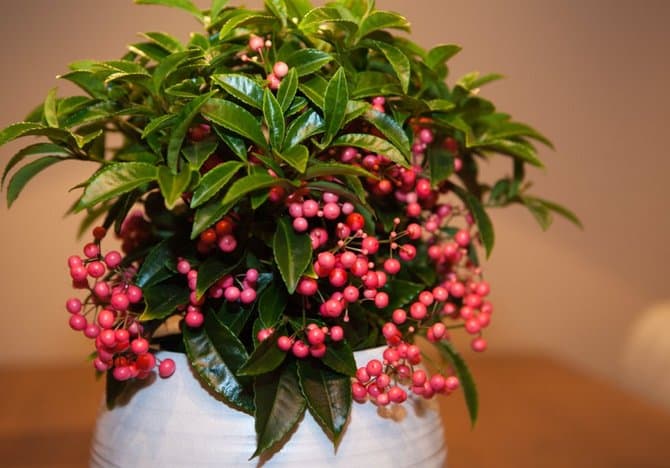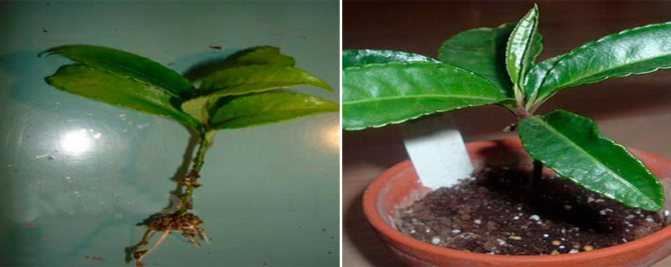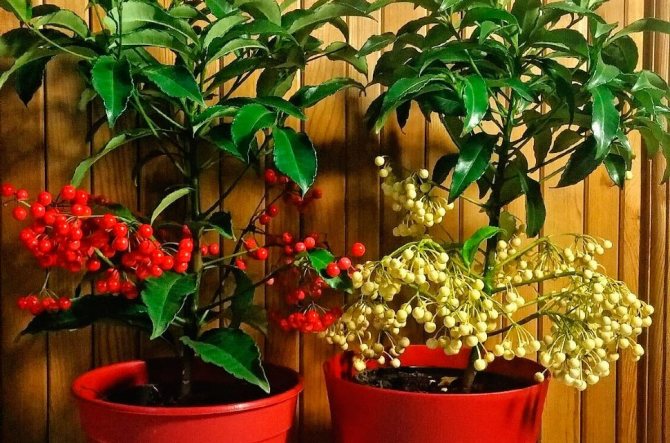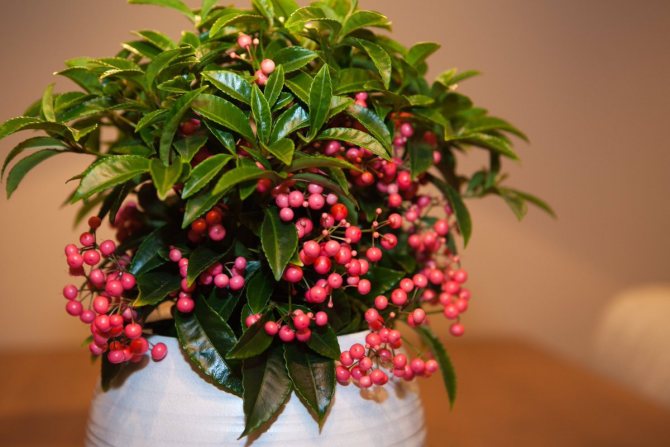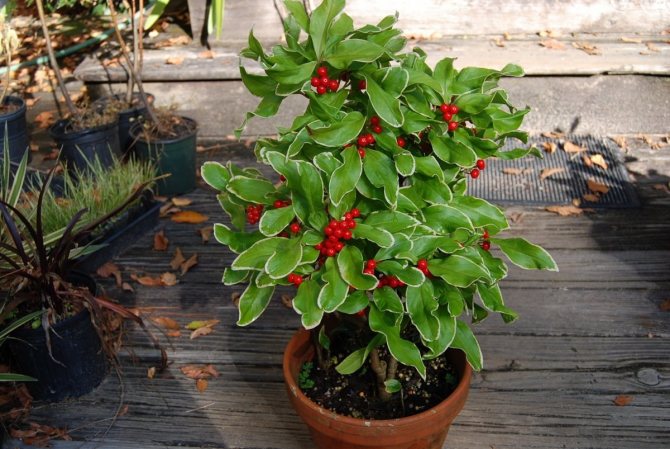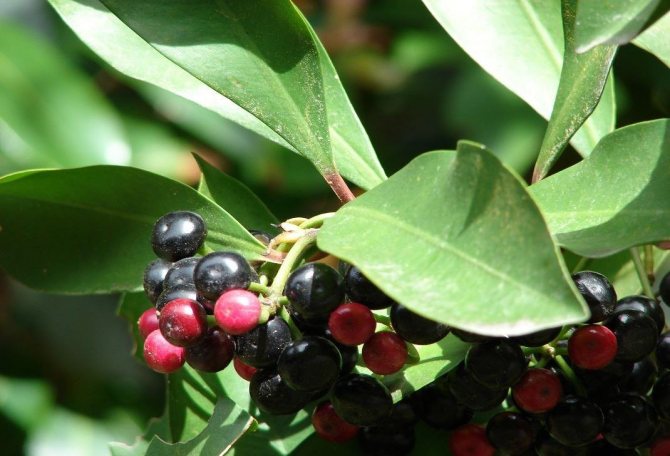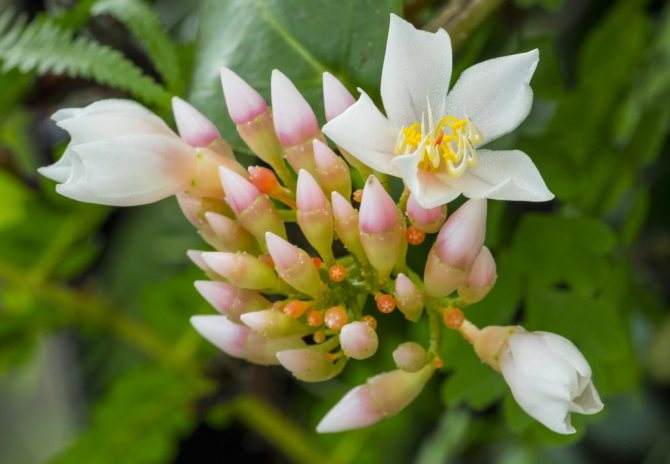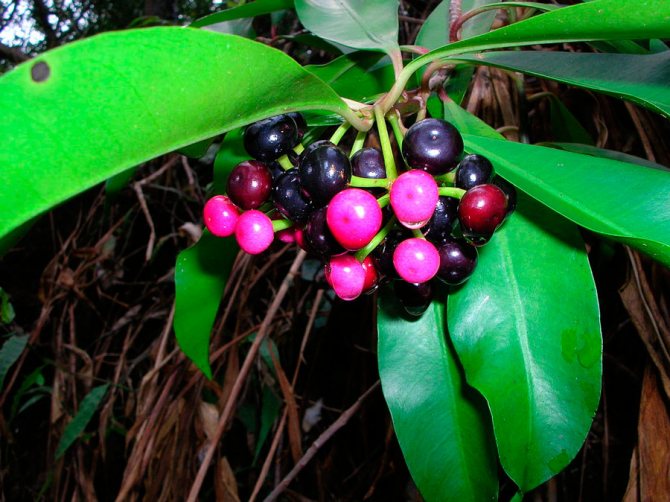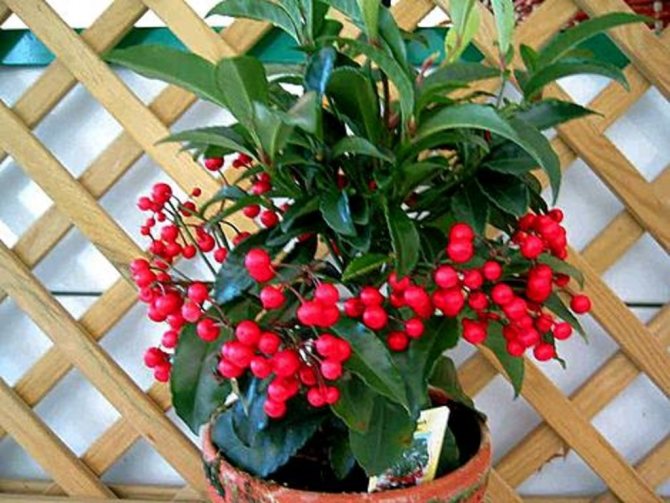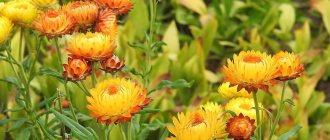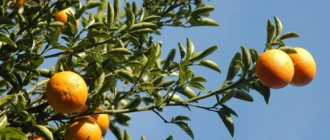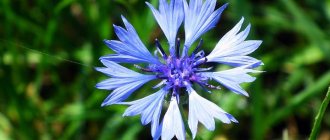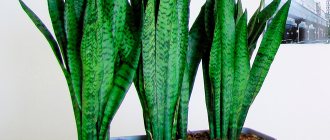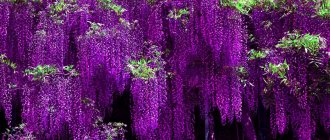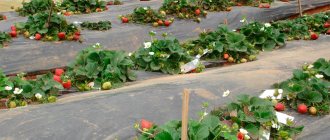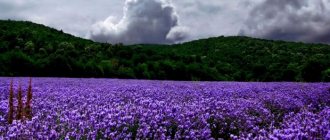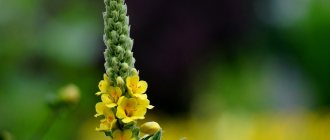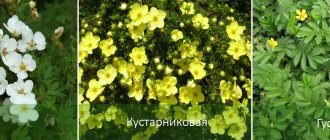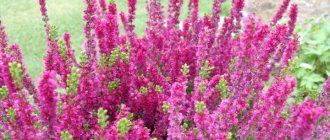At the moment, about 800 species of Ardisia are known. Her homeland is Japan and South Asia. The most common in the culture are Ardisia crenata and Ardisia crispa. Ardisia is a slow-growing plant that is attractive for its shiny leathery leaves, but its main value is its red berries, which appear in December. Ardisia berries develop from tiny flowers that bloom in summer and remain on the plant for several months. If the plant is properly cared for, it bears fruit all year round.
Ardisia, or Ardisia is a genus of woody tropical plants of the Myrsinoideae subfamily of the Primulaceae family.
Ardisia crenata (Ardisia crenata).
In the genus Ardisiy there are trees, shrubs or semi-shrubs. Leaves are evergreen, shiny, leathery, whole, alternate, opposite or whorled (three in a whorl). Flowers are collected in panicles, umbrellas, brushes; white or pink, calyx five-part, corolla five-part, spine-petal, with bent lobes; stamens five, long, protruding far. The fruit is a spherical, smooth, brightly colored drupe.
Features of the content of ardisia at home
Location: Preferably a bright place where the sun is only in the morning. The temperature in summer is 18-20 ° С, in winter 15-18 ° С. An excellent perennial plant for a moderately warm room.
Lighting for ardisia: This plant loves bright light.
Watering ardisia: The soil must be constantly moist throughout the year.
Air humidity: Humidity should be moderate, not high. In order for the berries to form, the air humidity must be more than 60%.
Top dressing of ardisia: During the growth period, once every two weeks, in winter - once every four weeks, ordinary flower fertilizers are applied. Features: for better berry formation, the flowers are pollinated with a brush.
Ardisia transplant: Recommended to replant every one to two years, in spring, in good clay soil for flowers.
Remember:
- purchased plants are grown using growth-retarding chemicals, so the internodes of branches grown after purchase will necessarily be longer;
- buds are laid in winter, at low temperatures (15-18 ° C);
- moist air is desirable for setting a sufficient number of fruits.
Botanical description
Evergreen. Belong to the Mirsin family. Grows in wooded areas of the tropics and subtropics. Distributed in America and Australia. Literally translated, the name sounds like "arrow". The corolla of a flower resembles an arrow.
Leaves are elliptical, glossy, leathery. The surface is smooth. A consistent arrangement of leaves is characteristic. In different species, the edges of the leaves are serrate, whole, crenate. Inflorescence is an umbrella or panicle. Flowers are bisexual, small, white. Less often cream or pinkish.
After flowering, a fruit is formed - a single-seeded berry. The color is red, sometimes yellow or white. Ripening lasts several months, starting in December. As a houseplant, ardisia acquires special attractiveness during the fruiting period. The berries are not edible!
Interesting information! At the edges of the leaves of ardisia, specific swellings are formed.Novice flower growers, out of inexperience, often mistake them for a manifestation of the disease. Trimming leaves with bulges is highly discouraged! Ardisia lives in symbiosis with nitrogen-fixing bacteria. Without their participation, the plant will not be able to assimilate nitrogen from the air and will die! The bulges on the leaves are the habitat of these bacteria. They are also present on the roots - they handle the root system very carefully during transshipment.
Ardisia care
One of the important conditions for the development of ardisia is good lighting, but it must be shaded from the midday sun. The plant should be watered regularly, as the topsoil dries. In winter, watering should be reduced. At the same time, the flower requires a cool content with an air temperature of about 15-18 ° C. At the end of February, they transfer it to a warm room and begin to feed it with fertilizers. This is done every two weeks.
Ardisia loves humid air, despite this, it is impossible to spray the bush on which the berries have set. Pallets with wet pebbles will help create comfortable conditions for the plant. Once a month, wipe the leaves with a damp cloth. This must be done carefully so as not to hurt the berries.
The flower is transplanted once a year into a mixture of leafy earth, peat and sand. Drainage must be placed on the bottom of the container. The volume of the pot is slightly increased during transplantation, since it is believed that ardisia blooms and bears fruit better in a cramped container.
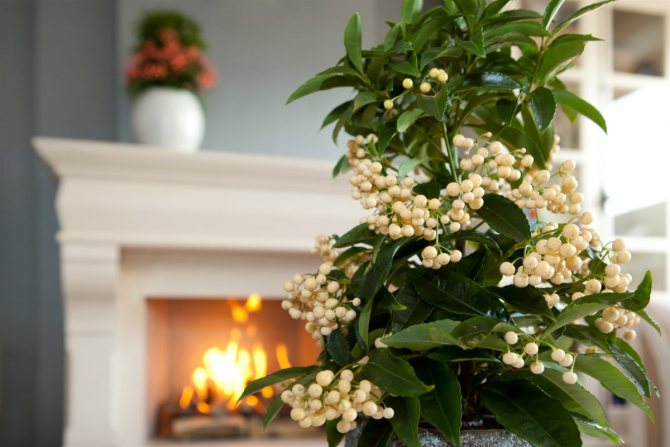
Ardisia. <>
Possible problems, diseases and pests of ardisia
With mistakes in care, the plant can get sick, lose its decorative appearance:
| Problem | Cause | Elimination methods |
| Yellowing of greenery. |
|
|
| Aphid. |
|
| Shield. | |
| Mealybug. | |
| Spider mite. | |
| Lack of lighting. |
|
| Falling foliage. |
|
|
| The tips of the leaves are brown and dry. | Low humidity. |
|
| The softness and curl of the plates. |
| Normalize conditions of detention. |
Reproduction of ardisia
Young plants are grown from seeds. For germination, take the largest ripe ardisia berries up to 1 cm in diameter. Having freed it from the pulp, we find a hard round bone (0.5 cm) with longitudinal light veins, vaguely resembling unripe gooseberries. We plant it to a depth of about 1 cm in a uniformly moistened substrate, cover the pot with glass or transparent film.
Sowing is carried out in March in seed soil. The soil temperature is maintained at 18-20 ° C. Ardisia seeds germinate at normal room temperature. The grown seedlings are transplanted one at a time into small containers filled with ordinary potting soil. Only after 2-3 years will the seedlings turn into attractive bushes.
Before planting, it is recommended that the hard bones of ardisia be scarified (carefully filed) and soaked for several hours in a solution of stimulating drugs.
From cuttings, plants develop faster, but cuttings take root not easily, at a soil temperature of at least 25 ° C.
Growing problems
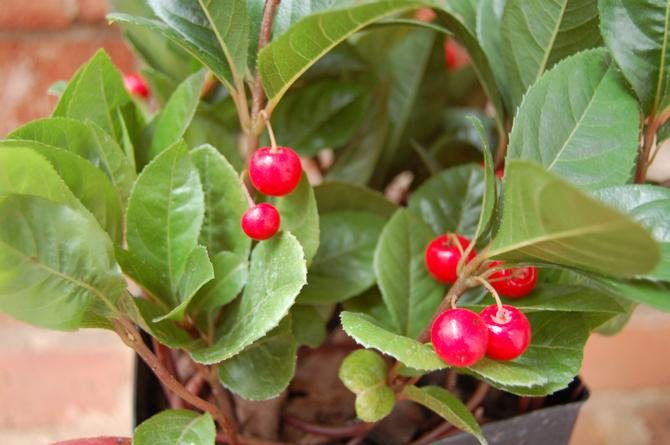

Among the possible difficulties that flower growers may encounter when growing ardisia, there are:
- Leaves lose their color - this comes from an overabundance of lighting.
- Leaves turn yellow - too dry air, poor lighting or insufficient amount of mineral fertilizers in the soil.
- The edges of the leaves turn brown - unregulated watering, dry air or lack of lighting.
- Leaves become covered with brown spots - excessive watering or humidity, infection with fungal diseases.
- The leaves have soft edges, curl - the day or night air temperature is too low.
- The edges and tips of the leaves dry out - the presence of drafts or too dry air.
- The appearance of dry light spots on the leaves - possible sunburn due to direct sunlight.
Subject to all the rules of cultivation, ardisia will certainly delight you with its beautiful flowering and bright fruits.
Types of ardisia
Ardisia crenata (Ardisia crenata)
Ardisia crenate is widespread in culture - an extremely attractive and interesting plant. Over a year, bright red berries can decorate ardisia, then they shrivel and fall off. The culture grows up to 2 m in height. Especially decorative are leathery dark green leaves with a wavy edge, with nodular swellings. In place of white or pink flowers, coral-red berries form in winter.
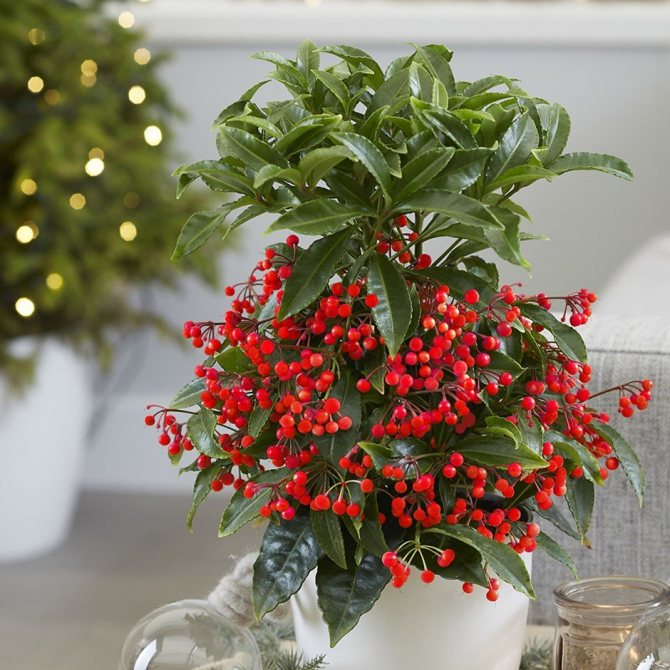

Ardisia crenata (Ardisia crenata). <>
Ardisia curly (Ardisia crispa)
Much less common is Ardisia curly - A. crispa - 60-80 cm high. It has leathery alternate, oblong-lanceolate, glossy dark green leaves with a wavy edge. In June, star-shaped white-cream flowers with a reddish tint bloom, collected in fragrant panicles. Ardisia curly fruits are very decorative, bright red round berries that often adorn the plant when it blooms again.
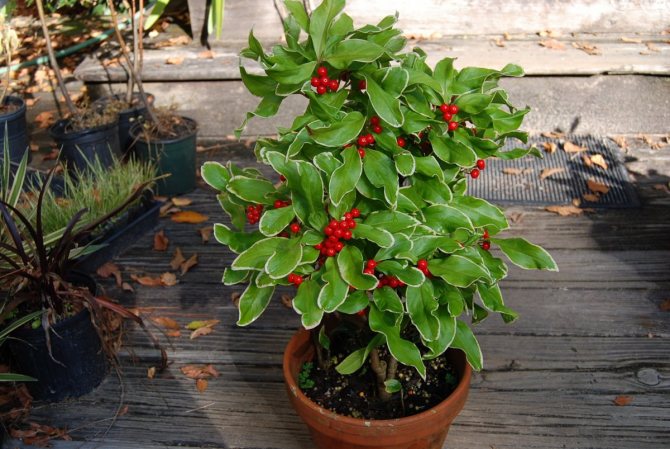

Ardisia curly (Ardisia crispa). <>
Ardisia low (Ardisia humilis)
Ardisia low - smaller than curly ardisia. She has dark green leathery leaves 5-15 cm long. Small light pink flowers, collected in drooping paniculate inflorescences. The berries first have a brownish-red color, then they become glossy and blacken.
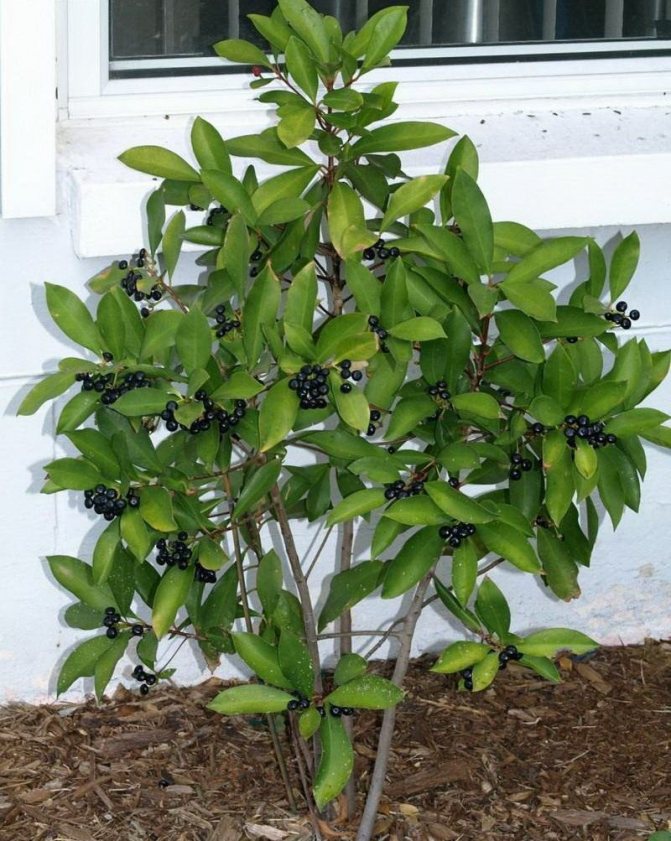

Ardisia low (Ardisia humilis). <>
Ardisia solanacea (Ardisia solanacea)
Ardisia solanacea is a species with reddish shoots and leathery light green leaves, narrower than those of curly and low ardisia. The pink or lilac flowers are completely inconspicuous. They are replaced by berries, at first reddish, later dark and glossy.
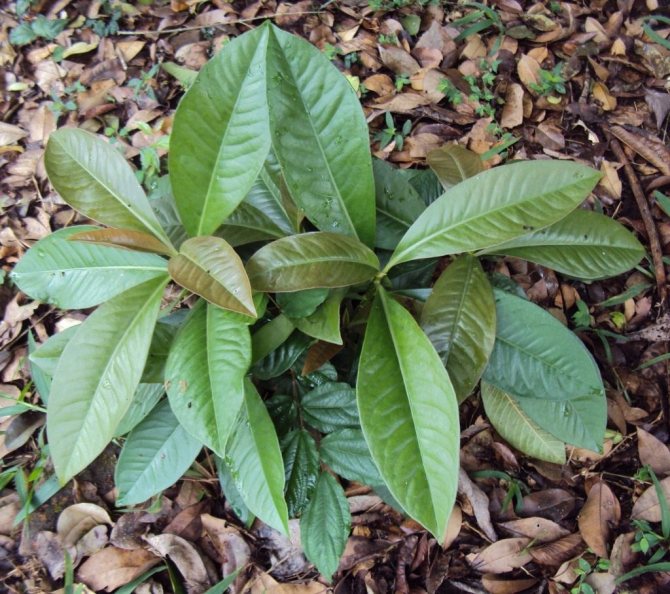

Ardisia solanacea (Ardisia solanacea). <>
Also occurs Ardisia Wallich (Ardisia wallichii), which is a much larger plant. Leaves up to 20 cm long, 6-8 cm wide, obovate, wedge-shaped narrowed at the base, entire. The flowers are bright red, the fruits are black.
Magical properties
- The ancient Greeks believed in the miraculous power of coral jewelry, believing that the magical properties of the mineral can prolong life and protect against disasters.
- For its external resemblance to a powerful symbol that gives soldiers strength and courage, and girls beauty and health, magnificent ardisia is popular among indoor plants.
- A flower grown at home has a beneficial effect on the human psyche and protects against the evil eye.
- Each plant in the house has a certain energy and creates a comfortable atmosphere, cleansing the space around it.
You should not decorate the nursery with a coral tree because of the glossy appetizing berries that the baby will certainly want to taste.
What care does this original plant need?
- Lighting. It should be absent-minded. Because of this, many keep ardisia not on the windowsill (if it is not western, but southern), but on the table. In winter, when the flower begins to "be active", even the window sill will not be enough for it, and the plant will have to be illuminated artificially.
- Temperature. In summer, ardisia suffices plus or minus 22 degrees, in winter - 16-18. Although if the room gets colder (up to +7, but not lower), the flower will survive. But if it gets hotter, few flowers will bloom on the tree, and the berries may sprinkle.
- Watering. During the period of activity of the bush, do not save water (but, of course, so that it does not stagnate in the pot). Carry the watering can as soon as the top of the ground is dry. If ardisia is cold in winter, it should be watered less often, preferably with warm or at least room water. Always remove moisture that will drain into the pallet.
- Spraying. They are desirable for the flower, but not during the flowering period. However, the flower needs moist air, so place a container of water next to it, let it evaporate.
- Food. The flower is pampered with complex mineral fertilizers from the end of February to September (inclusive). They are given twice a month.
- The choice of soil. It should be neutral, light, nutritious. A good option is a mixture of peat, sand, deciduous soil. The addition of charcoal can make the soil more nutritious and safer in terms of diseases. And don't forget to drain to the bottom of the pot.
- Pruning. To make the bush look beautiful, every spring it is worth removing the twigs that have come out of the crown.
- Pollination of a flower. If you have one, it is worth "working as a bee", transferring pollen from flower to flower with a cotton swab. Although if there are two ardisia in your room, you can do nothing - the plants will "make friends" themselves.
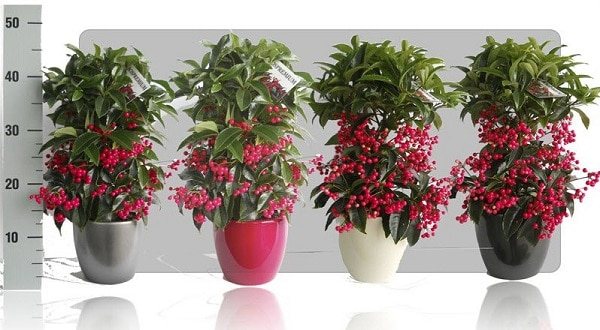

Transfer
Use the transshipment method.
- Transfer the newly purchased tree 2 weeks after the purchase (letting it come to its senses after moving from the store).
- A young tree (up to three years of age) is transplanted annually, an older one - much less often, only when the roots become cramped. So that the soil in the "old woman's" pot does not acidify, it is collected from above and replaced with a new one.
This procedure is carried out in the spring.
Cuttings
This propagation method is very difficult, as the cuttings are difficult to root. Only the tops of the tree are cut into cuttings. The cuttings are placed in a solution with a growth stimulant for several days, and then planted. But the advantage of this method is that such plants will bloom much earlier than those grown from seeds. When the cutting takes root, it is transplanted into a separate pot and kept in a bright place. When the plant grows up, it is simply transferred into a more spacious flowerpot.



